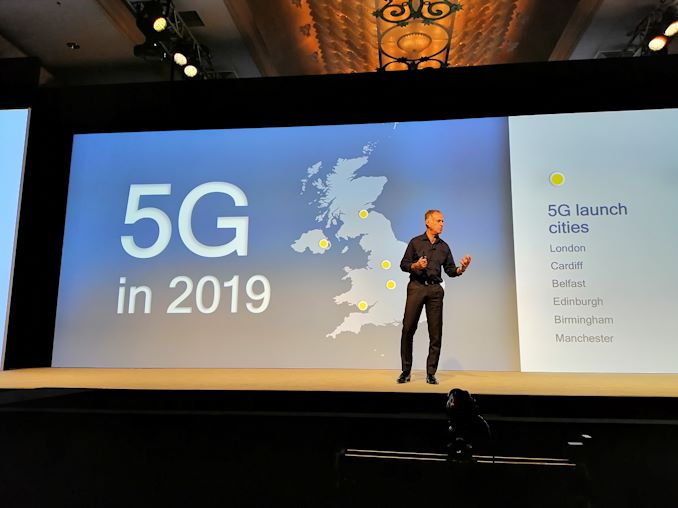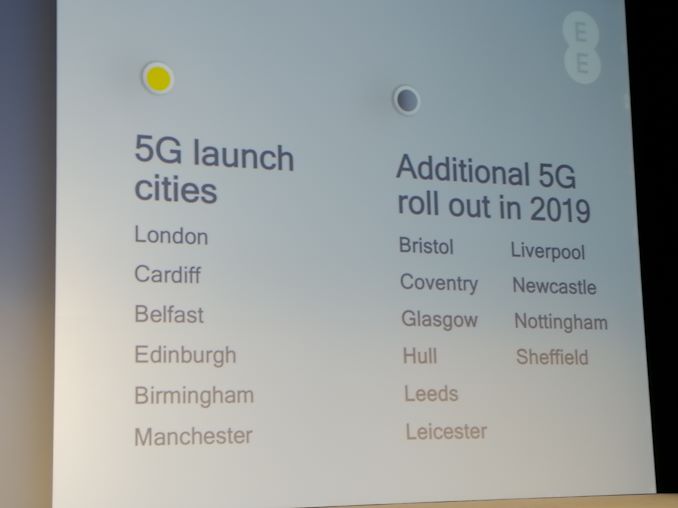Implementing 5G in the UK: EE Trial Sites and First Cities
by Ian Cutress on December 12, 2018 4:00 PM EST- Posted in
- 5G
- Snapdragon
- Qualcomm
- EE
- BT
- London
- Qualcomm Summit 2018

As a Brit, having one of our local companies get on stage at Qualcomm’s Snapdragon Summit and talk about the deployment in the UK was certainly an interesting twist in the proceedings. Fotis Karonis, The BT/EE Group Executive Advisor on 5G, presented a list of the first cities in the UK to get 5G as well as the second wave, but before this we also got a peak at the first 5G trial sites in London.
UK and EE Deploying 5G
Everything Everywhere, commonly known as EE (formed when Orange and T-Mobile came together), was acquired and rolled into the British Telecom group in recent quarters. As a result of BT’s enablement of the UK mobile infrastructure, it makes sense that it would be the first provider to provide 5G connectivity. To start with, EE is going to launch 5G to six cities:
- London
- Cardiff
- Belfast
- Edinburgh
- Birmingham
- Manchester
These are the most densely populated areas of the UK, which makes overwhelming sense. Fotis explained during his part of the keynote that the UK has just over 90,000 mobile network base station sites from top to bottom, however only 1500 of these are needed to enable data and call services to 25% of the traffic required. That’s a highly lopsided deployment based on population density for sure, and so it is these 1500 sites that will be targeted first.
The second wave of deployment, listed as being in 2019, will cover the other major metropolitan areas of the country (in alphabetical order):
- Bristol
- Coventry
- Glasgow
- Hull
- Leeds
- Leicester
- Liverpool
- Newcastle
- Nottingham
- Sheffield
It should be noted that with all this going on, it was recently mentioned to the press that BT/EE is currently removing Huawei infrastructure from the core of Britain’s 3G and 4G network backbone, with the company opting for other alternatives. Huawei hardware is still deployed at the edge, but not for crucial services, as explained to the BBC. The UK government is looking into whether it should analyse Huawei’s infrastructure options for full 5G rollout.
Even with that, EE is implementing 5G trials across the country, partly with Huawei. These hardware trials are occurring before on-location trials, which Fotis also mentioned. The following areas, in the East End of London, will be the first for the 5G on-location trials due to the level of foot traffic they receive:
- Provost Street
- City Road
- Central Street
- Old Street
- Cheapside
- St. Paul’s
- Finsbury Circus Garden
- Clerkenwell Street
- Bartholomew Square
It is unclear exactly how users will be able to be part of these trials, or if EE will trial the 5G-to-Wi-Fi mobile hotspots for businesses first as we have seen with Verizon in the US.
Another factor here is OnePlus. At the Qualcomm event, OnePlus announced that they would be (one of) the first to have a 5G enabled device, and that their devices would enable the first wave of 5G adoption within the UK on the EE network. We’re starting to work with OnePlus especially as this rolls out so we can bring you all the relevant information about how 5G is turning out.
Stay tuned for more information as it is announced.













6 Comments
View All Comments
PeachNCream - Thursday, December 13, 2018 - link
A technologically advanced nation with areas of high population density like the United Kingdom would be ideal for deployment of 5G as a first run. Trying to deploy that kind of technology in the US, for example, where there are large swaths of rural people that are unaccustomed to modern communication mechanisms and are spread thinly would be a poor choice for a first mass deployment.KingJ - Thursday, December 13, 2018 - link
Both the US and UK have similarly dense and rural areas - 5G is just as applicable in each country. Initially here in the UK, operators are targeting dense areas in order to provide capacity - despite oodles of 4G spectrum, 5 carrier aggregation etc speeds can be quite slow today in the areas that are being targeted for initial 5G deployments.Additional low frequency spectrum is also being unlocked for the 5G deployments, not of tremendous use in dense areas (apart from deep building penetration) but great for more rural areas where you only need a single mast to cover all the users in a fairly wide area.
PeachNCream - Thursday, December 13, 2018 - link
The population density numbers are quite different. In the United States, it is 35.35 persons per square km and in the United Kingdom it is 271.31, or rather was in 2016. A 5G deployment can easily reach a much larger number of people with a smaller investment of resources over a shorter period of time in the UK. I also think the rural US population is generously described as being technologically isolated. My personal experiences with living in and traveling through the southern portions of the US have only reinforced published research about that matter. I would think a corporation deploying a relatively new technology would prefer a population group that is generally given more and better education, stresses kindness in social interactions, and can articulate abstract concepts clearly as a means to reduce technical support personnel costs and improve employee quality of life.leexgx - Thursday, December 13, 2018 - link
but there are locations that are busy so you prioritise 5G there (does not really matter if its USA or UK you put 5G where its needed) you just talking about avg numbers not the hot spots where 5G is usefuldromoxen - Saturday, December 15, 2018 - link
Look, even in the City of london, its only going to cover a few streets... but there are plenty of very deep pockets that will pay to get this tech.It seems it will be 2020/2021 before its started for Jane Soap to get it, and even then it will be a premium service.Relish should be interested ...hbsource - Monday, December 17, 2018 - link
The population density figures for the UK as a whole are a bit misleading though. In reality the figures are skewed by the Celtic nations. England has well under 50% of the land area but around 80% of the population.